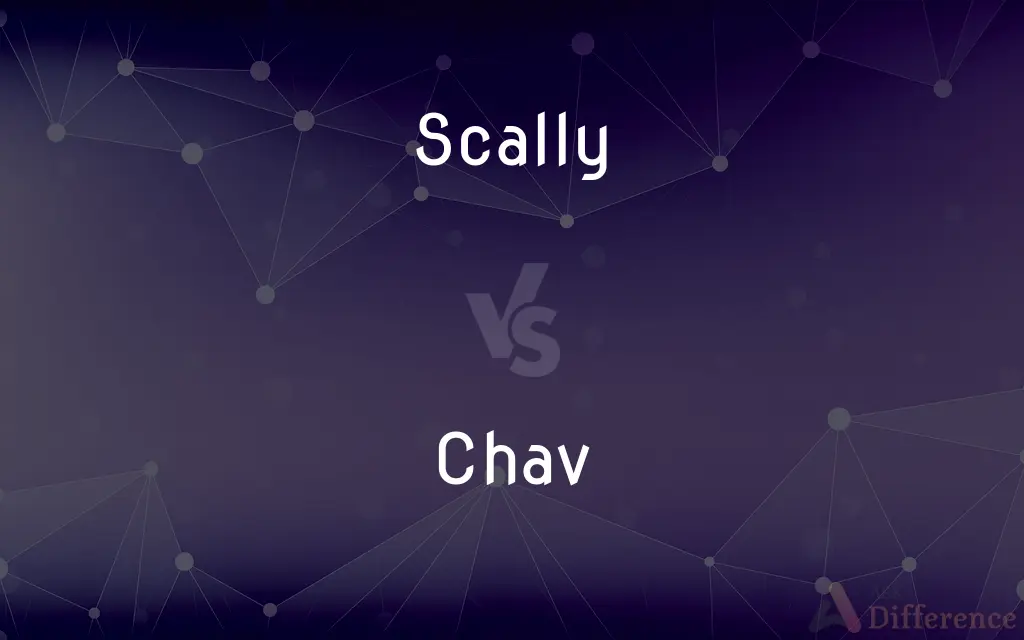Scally vs. Chav — What's the Difference?
Edited by Tayyaba Rehman — By Fiza Rafique — Updated on March 25, 2024
Scally is often associated with a working-class youth subculture in the UK, characterized by sportswear, while Chav is a derogatory term for certain young people, noted for their branded clothes and antisocial behavior.

Difference Between Scally and Chav
Table of Contents
ADVERTISEMENT
Key Differences
Scally is a term primarily used in the North West of England to describe a youth subculture associated with wearing sports attire and tracksuits, whereas Chav is more widely used across the UK to denote a similar group but with a stronger emphasis on flashy, brand-name clothing and jewelry.
Scally culture is often linked to the working-class neighborhoods of cities like Liverpool and Manchester, focusing on a sense of community and identity through fashion and music, on the other hand, Chav culture is perceived as spreading across various regions, often carrying negative connotations of vulgarity and antisocial behavior.
While Scallies are particularly known for their affinity for specific brands of sportswear, such as Adidas or Nike, Chavs are identified by their preference for ostentatious, designer labels, distinguishing their fashion sense from the more sports-oriented Scallies.
The term Scally also conveys a sense of belonging to a specific local identity and can have less pejorative undertones compared to Chav, which is widely regarded as a derogatory term reflecting societal prejudices and stereotypes.
Scally subculture includes elements of music and club scenes, focusing on electronic and house music, whereas the Chav stereotype often lacks this cultural depth, being more associated with rowdy behavior and a general disdain for authority.
ADVERTISEMENT
Comparison Chart
Origin
North West England
UK-wide
Clothing Style
Sportswear, tracksuits
Branded, flashy clothing and jewelry
Social Perception
Less pejorative, local identity
Derogatory, linked to antisocial behavior
Cultural Associations
Linked to music and club scenes
Associated with rowdy behavior, lack of cultural depth
Brand Preferences
Sports brands like Adidas, Nike
Flashy, designer labels
Compare with Definitions
Scally
A young person associated with a working-class youth subculture known for sportswear.
The group of scallies gathered at the corner, all decked out in their latest tracksuits.
Chav
A pejorative term for a young person displaying brash and loutish behavior.
The park was full of chavs blaring music without any consideration.
Scally
Typically associated with a specific taste in music and nightlife.
Scallies were the main attendees at the underground rave.
Chav
Known for wearing flashy, designer-label clothes often associated with vulgarity.
Chav fashion seems to thrive on being as ostentatious as possible.
Scally
Sometimes used interchangeably with "scouser" but with specific fashion connotations.
That scally style has really taken off across other cities now.
Chav
Represents a caricature of working-class youth by mainstream media.
The term chav has been criticized for reinforcing class stereotypes.
Scally
Often seen as embodying a rebellious, yet communal urban identity.
He identified as a scally, proud of his roots and local music scene.
Chav
Stereotypically linked to antisocial behaviors and disrespect for authority.
The chavs at the shopping center were causing trouble again.
Scally
Can have both positive and negative connotations depending on context.
He’s a true scally at heart, always sticking up for his mates.
Chav
Often used in a derogatory way to highlight a lack of sophistication or manners.
Their chav behavior at the restaurant was embarrassing to witness.
Scally
Scally (also spelled Skelly or Skally) and "Mac Scalaíghe” in Irish and “Mac Scalaí” in modern Irish is a surname of Irish origin.
Chav
"Chav" (), also "charver" and "scally" in parts of England is a British pejorative term used to describe an anti-social lower-class youth dressed in sportswear. "Chavette" is a related term referring to female chavs, and the adjectives "chavvy", "chavvish", and "chavtastic" are used to describe things associated with chavs, such as fashion, slang, etc.
Scally
(pejorative) A rascal or miscreant, a scallywag.
Chav
Used as a disparaging term for a poor or uneducated young person, especially one who behaves in a brash or vulgar manner and wears ostentatious clothing and jewelry.
Scally
A jobless yob who has little or no education and is suspected of having committed some type of crime.
Chav
A working-class youth, especially one associated with aggression, poor education, and a perceived "common" taste in clothing and lifestyle.
Scally
A flat cap or driving cap.
Common Curiosities
What distinguishes a Scally from a Chav?
Scallies are associated with sportswear and a particular region, while Chavs are known for branded clothes and antisocial behavior across the UK.
How are Scallies and Chavs similar?
Both are associated with specific styles of dress and are part of youth subcultures.
What is a Scally?
A scally is a term used to describe a youth subculture in the North West of England, known for wearing sports attire and tracksuits.
What does Chav mean?
Chav is a derogatory term for some young people in the UK, characterized by their flashy clothing and often antisocial behavior.
Is "Scally" a derogatory term?
It can be, but it's less universally derogatory than "Chav" and often carries local pride.
Can someone be both a Scally and a Chav?
Due to overlapping characteristics in fashion, some might see them as interchangeable, though culturally they have distinct identities.
How do Scallies and Chavs reflect societal attitudes towards youth?
They highlight how fashion and behavior can be used to stereotype and marginalize youth based on class and economic status.
What impact has the internet had on these subcultures?
The internet has allowed for broader dissemination of the styles and attitudes associated with these groups, sometimes leading to their commercialization.
How has the perception of Scallies changed over time?
Perception has evolved with the subculture becoming more mainstream and less tied to specific social or economic status.
Are Scallies only found in Liverpool and Manchester?
While the term originated there, the style and subculture have influenced other areas.
Why is the term Chav considered offensive?
Because it stereotypes and demeans individuals based on clothing and perceived social status.
Are Chavs a uniquely British phenomenon?
While the term is British, similar stereotypes exist globally, though they may carry different names and specific characteristics.
Can these terms be reclaimed positively?
Some individuals and groups have attempted to reclaim these terms, focusing on community and resilience rather than negative stereotypes.
Has the Chav culture been misrepresented by the media?
Yes, many argue that the media portrayal exaggerates negative stereotypes and ignores the socio-economic factors at play.
What role does music play in Scally culture?
Music, especially electronic and house, plays a significant role in uniting the Scally community and shaping its identity.
Share Your Discovery

Previous Comparison
Cognitive vs. Conative
Next Comparison
After vs. PostAuthor Spotlight
Written by
Fiza RafiqueFiza Rafique is a skilled content writer at AskDifference.com, where she meticulously refines and enhances written pieces. Drawing from her vast editorial expertise, Fiza ensures clarity, accuracy, and precision in every article. Passionate about language, she continually seeks to elevate the quality of content for readers worldwide.
Edited by
Tayyaba RehmanTayyaba Rehman is a distinguished writer, currently serving as a primary contributor to askdifference.com. As a researcher in semantics and etymology, Tayyaba's passion for the complexity of languages and their distinctions has found a perfect home on the platform. Tayyaba delves into the intricacies of language, distinguishing between commonly confused words and phrases, thereby providing clarity for readers worldwide.
















































